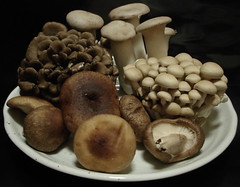I dont know why but over my last week mushrooms have loomed large.
Maybe its North Korea and its nuclear test.Or the fact that its the in-season for the fungi and they feature prominently in supermarket vegetable and fresh produce aisles.Or maybe because of the report earlier in the week of a man being attacked by a bear while out "hunting" for mushrooms.
In Japanese kinoko (mushrooms) translates charmingly as "tree children".There are around 4,000 or so species of mushrooms in Japan.Some poisonous.Some are mycorrhizal which means they are only found in the wild.The best example being matsutake.
The matsutake or red pine mushroom only grows for a few weeks in areas of red pine trees.Sought after for its fragrance and taste Japanese matsutake are expensive.Around 5000 yen a small specimen.Or you can opt for cheaper imported ones from China,Canada and until recently North Korea.
The mushrooms in the photo above are readily available all year round.They can be found in local supermarkets and greengrocers.These are four common types I regularly cook at home or eat at restaurants.
Shiitake.Grown in Toyama these brown velvety capped mushrooms in the front are shiitake.They can be used to make a mushroom tea and are also popular as a base for soups.Grilled,fried or simmered they are apparently the most common mushrooms used in East Asian cooking.You can also buy them dried.
Maitake.These came from Shizuoka.Directly behind the shiitake on the left are the maitake or "dancing mushrooms".Sold in a clump they have brown fan-like tops that overlap like wooden roof shingles.I usually saute them in a little butter and garlic.Delicious.
Eringi.From Gifu these are at the rear of the photo.They are large stumpy mushrooms that have thick stalks and quite flat caps.They are quite firm when you cut them and I usually cut off the tough stalks before cooking them.Again sauteed or fried in butter with bacon and eggs is a personal favorite.
Shimeji.From Shikoku.On the right hand side of the photo are some shimeji.Like maitake they are sold in clumps.There are various kinds with both white and brown caps.They can be used in nabe(stew) or miso soup.
As mushrooms absorb liquids easily I dont wash them under running water.Instead I was advised to lightly brush or clean them with a paper towel or cloth.Likewise they taste best if not drowned in butter or oil when cooked to retain their taste and flavour.
Finally in English when we refer to different kinds of mushrooms,for example, shiitake we say "shiitake mushrooms" but in Japanese this is unnecessary.In Japanese shiitake or for that matter shemiji is sufficient.......
Monday, October 16, 2006
Subscribe to:
Post Comments (Atom)



No comments:
Post a Comment